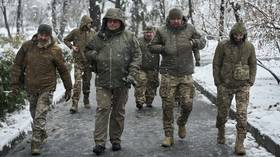Gold rush speeds erosion of taiga hunters’ lifestyle
Russia’s Amur Region is a land of an awe-inspiring wilderness with long-held traditions cherished by local people. But the region’s resources are attracting the march of industrialization, which could pose a threat to that ancient lifestyle.
In the depths of the Far Eastern Amur Taiga, if you look hard enough, you can still find evidence of the traditional hunter-gatherer Evenk lifestyle. The Evenk people have survived by living off the land, and their way of life stretches back generations.But their numbers and culture are fading. With the passing years, there are fewer and fewer places for them to drive their reindeer packs to. And the elders say they know who to blame.“We are dying out and it’s all because of the gold miners. They’re barbarians. They’re destroying the Taiga which has always been our life source. Now it can’t even provide us with enough food. They’ve destroyed our home, taken everything from us and offered nothing in return,” believes Arkadiy Khokhlov, an Evenk elder.Whether a blessing or a curse, Amur is a region abundant in natural resources. And with gold currently trading at an all-time high, the pressure to produce is greater than ever.There are few places where this is more true that at the Malomyr Mine. It is operated by Russia’s third-largest gold miner, Petropavlovsk PLC. Founded in 1994, the joint Russian-British venture says it will increase production this year by 33 percent to some 17 tons.The gold extraction process begins with several small holes drilled and filled with explosives and then blasted. Approximately 30,000 to 40,000 tons of rock will be broken up with each blast. The process generates huge amounts of waste.“We are mining at this operation ore with a grade of three grams for each ton of ore. Now a ton of ore is a million grams. So out of those one million grams, three of them are particles of gold. And we have to recover those three,” says Martin Smith, Technical Director of Petropavlovsk PLC.It is the proverbial needle in a haystack, an equation that just does not add up for those who see the Taiga as their home.Others are more pragmatic and see it as an inevitable consequence of living in a lucrative landscape."There are gold miners in this area, who have been working for more than a 100 years. They have already done a lot of damage. But here, there is new technology. New technology to obtain the gold and to store waste materials,” says Dr. Sergey Smirensky, who assessed the environmental and cultural impact of Petropavlovsk Mine expansion.“We talked with the indigenous people, with the Evenks in this area. Not all are happy. But I must say that most people say ‘ok, this gold mine will bring us more than we had before and improve our life standards,’” he adds.The mine means more jobs and cultural, sporting and schooling programs – all funded by it. But it is the price of prosperity that could spell untold environmental damage and see centuries of Evenk tradition driven to extinction.













